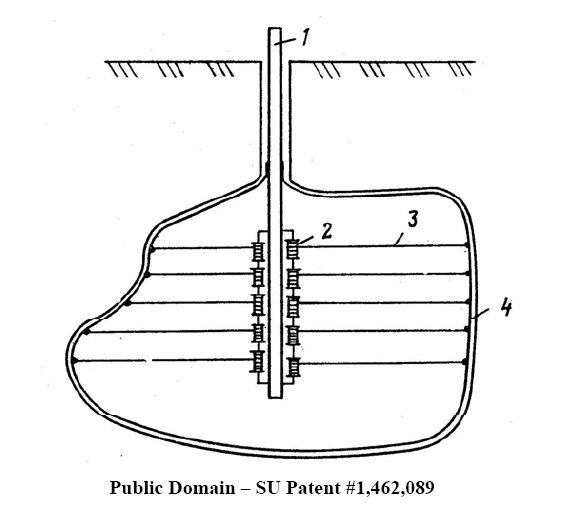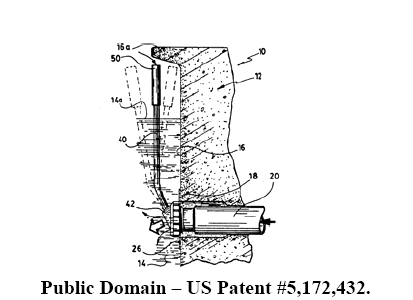STUDENTS CORNER #1 - From air bubbles to Nobel Prize!
Editor | On 28, Jan 2006
Dr. Abram Teplitskiy STUDENTS CORNER #1
From air bubbles to Nobel Prize!
We’ll start our first STUDENT Corner in TRIZ Journal with discussing air balloons
and air bubbles. We are sure that all students have experience in this area while playing with air balloons or with air bubbles. As example, you can observe a pig-like air balloon.

An expandable toy having a plurality of fabric panels joined along their sides forming a desired shape and defining an interior space. These panels also define a single aperture at the top of the toy that provides access to the interior space. A plurality of elastic bands runs along the interior surface of the fabric panels. Air is forced into the inflatable device, expanding the inflatable device and when large enough expanding the plurality of elastic bands so that the toy may achieve a desired size. The inflatable device is then sealed and a fabric lid is closed to cover the single aperture when the desired size is achieved. Next example shows how air balloons could help to solve practical problems. We demonstrated students in our Creativity Class a picture, in which a cat with injured paw like in the picture below, and asked how students can help injured cat. To give students a helping hand, we show them air balloons.
Image of a balloon gave students a clue – hang the injured paw to a balloon and make it suspended.
A misery Cat. It can’t walk on its fours.
A misery Cat. It started to cry.
To cure my pet, balloons I should buy.
Astonished crowd: in accordance with laws
A misery Cat. It has cut one of the paws.
Attired by different kinds of festoons,
My cat partly walks along a road on paws,
And partly is flying … is flying with the help of balloons.
Poem was written in Russian by Irina Tokmakova, Translated in English by Nikolay Rudenko Can readers imagine any practical use of a balloon besides those for entertainment? You say it’s difficult to imagine? Let’s discuss some practical problems. Imagine that you are in a place where there are low temperatures at wintertime. An underground water pipeline was built in this area, and we know that water could be frozen at such low temperatures. While freezing, water expands and could break the pipeline. How to prevent such breakdown? Think if air balloon could help you? If you didn’t get an idea, read one inventor’s proposal. He advised to insert in a pipeline set of balloons filled with air. While freezing, ice will expand, but air will balance this extra volume of space because of its contracting under pressure (RU Patent #2004109831).
Next example of balloon practical application is also from construction area. For testing density of compacted soil, which contains big (particles), we invented a method, which includes following operations – dig a pit, weigh all soil extracted from the pit, and measure the volume of the pit. Weighing operation is very simple, but how to determine the volume? Technological instructions recommended put inside a pit a flexible membrane and fill it with water – amount of water in completely filled pit will be equal to the volume of the pit. To use such method it’s necessary to keep a lot of water in field conditions. Moreover, operations with water in winter are very complicated because of water possible freezing. You already know from above example that air balloon could help, but how?
Think, what is around us in any place, and you will immediately find out that such material is … air! But how to operate with air, how to put it in a small pit? We think, 3 that every student would give the answer – we need to use air placed in balloon! The idea is simple – put in a pit a balloon with air, level the upper “boundaries†of balloon with soil level, extract the balloon from the pit, put it in a box with known volume (like bucket), and using Boyle Law, calculate the volume of a pit.
What we need to measure is only pressure of the air inside the balloon in both cases – in a pit and in a bucket. By Boyle Law, we can write a balance equation: P1 x Vx = P2 x V2, and calculate from it the volume of a pit: P2 x V2
where P1 V2 – Volume of a box,
P1 and P2 – air pressure in a soil pit and in standard capacity respectively.

All this sounds great, but while we put the balloon in a pit, pumped air inside, we were not able to extract the air balloon from the pit without tearing the balloon. What to do? We faced a contradiction – from one side balloon has to fill all the internal space of the pit, but has to be easily extracted.
Idea came later – use a balloon of size much bigger than pit’s volume. When putting in a pit, the balloon will be pressurized to walls of a pit, and we can measure the volume of air inside such a “box.†Then we easily can extract the balloon, because after opening the pit by taking off the lid, which covered the pit, balloon will spread it’s shell, the pressure inside balloon will reduce, and we can put the balloon in box, and measure the pressure of air in it. The idea of using a balloon of big size and fold the balloon before it was placed in the pit resolved the problem.
Let’s discuss one more problem – in some areas where people extract natural resources from underground space, for example coal or stones for buildings. After extraction it would be empty space underground. If in future people would decide to build in such areas, they should provide investigations of the underground space: how much emptiness is their underneath. How to provide such investigations, and what simplest methods and devices could be used for this purpose? Students from Ukraine proposed to use for this purpose – air balloon! General scheme of proposed method is illustrated in the sketch below. The idea of students invention (SU Patent # ) was as follows: install inside a balloon a vertical stick, and put on this stick as on the axle several 4 bobbins with wounded thread, and connect ends of each thread with internal surface of the balloon. Now imagine what would happen if you’ll pump inside the balloon air. The balloon would expand until it would reach the walls of underground emptiness. By the length of the unwounded thread it could be determined diameters of the emptiness on all its depths. In the picture below it is not shown the measuring part of this tool, which could be developed by students-readers, because our purpose was to show how to apply the balloon potential.

Above we acquainted with different applications of air balloons for solving practical problems, and now answer, please, a simple question – can air balloon be used without its shell?
If balloon has no shell, something has to surround a “piece†of air. We think that everybody could easy to imagine a portion of air without any shell in water. And readers would immediately remind their title – air bubbles. Most of students will imagine air bubbles in water; for example, in aquarium everybody could witness how air bubbles exhaled by fish are streaming to the water surface. Air bubbles have a lot of helpful application in human life. First of all, think that while training water divers are doing hundreds of dives, and unfortunately often they get traumas during impact of water, which under such speed behavior as enough rigid substance. How to make water softer? Help came from … air bubbles! If saturate water with air bubbles, such airwater mixture would be more hospitable for divers. It even was developed a department in industry, which deals with creating special devices called aerators, manufacturing and installing them not only in swimming pools and aquariums, but also in wastewater treatment plants, where air is serving to purify wastewater. Example of such aerator for a pool is shown in the picture below taken from US Patent # 5,172,432.
An aerating device shown above, besides saturating water with air bubbles and therefore making it softer and safer for divers, also is supplying water with disinfection’s materials, which making water healthier as for divers and for general public who came in the poll for leisure. But most of aerating industry is working for purifying wastewater at wastewater treatment plants. Aerators supply wastewater facilities with oxygen by pumping inside wastewater air bubbles. The main feature of aerator in this case is supplying as much oxygen, as designed by project through dispersing small air bubbles. Smaller air bubbles constitute bigger summarized surface area of bubbles, and therefore degree of purification would be higher. Author’s colleagues from Ukrainian Ecopolymer Company developed one of the best types of aerators in the world. These aerators also were patented and implemented in the USA, China, South Korea, and many other countries over the globe. Melted polymer was sprayed on the surface of aerator’s tube, forming a porous covering with the finest pores. General look of such aerator is shown in the Fig.
By the example of aerator we can suppose that fine air bubbles are occupying the porous space of different materials. Practice shows that such conclusion is right. As example, let us consider the heat isolation on pipeline. In many cases heat insulation contains up to 95% of hollow micro spheres as shown below.

Now, to encourage yourselves, read how the air bubbles concept resulted in a Nobel Prize. American physicist Donald A. Glaser thought about registration of radioactive particles of high energy. He came up with idea to put some liquid under high pressure, and heat it to the temperature higher than the temperature of boiling under room temperature. When putting a source of radioactivity close to this vessel, the liquid will boil, making … bubbles! Using these bubbles, scientists could recognize and classify different unbelievably small particles. For inventing the so-called “Bubble Chamber,†Glaser was awarded with Nobel Prize in Physics.
Now we foresee a question, where do you find problems to solve? The answer is simple – look around, and you will certainly find them. There are a lot of problems in the world. Some, like earthquakes, flooding, tornado, and depositing nuclear waste, have existed for a long time. Others are not so obvious; they hide from us and constitute an unusual “country†of unsolved problems. We proposed you two simple problems we picked up in this endless country. Everybody knows that a running car is accompanied by wind. Now a problem – how to use this wind? Also, everybody knows that apricots contain pits. Another problem for readers – how to use these pits? At next our meeting at “Students Corner†we’ll discuss solutions to these problems.
So, keep your eyes open and see how you can find and solve problems. You never know where it might lead. Happy inventing. Illustrations by Merle and Kelly Cunningham






